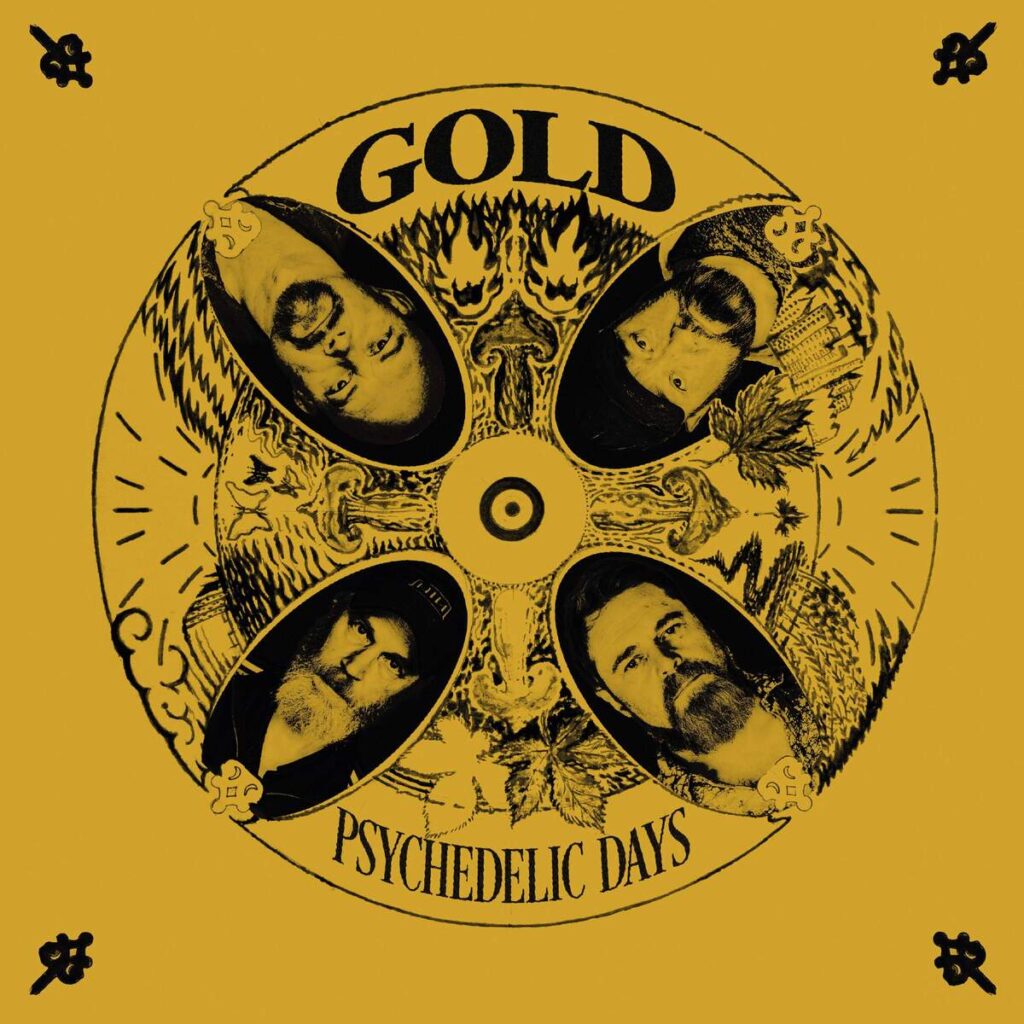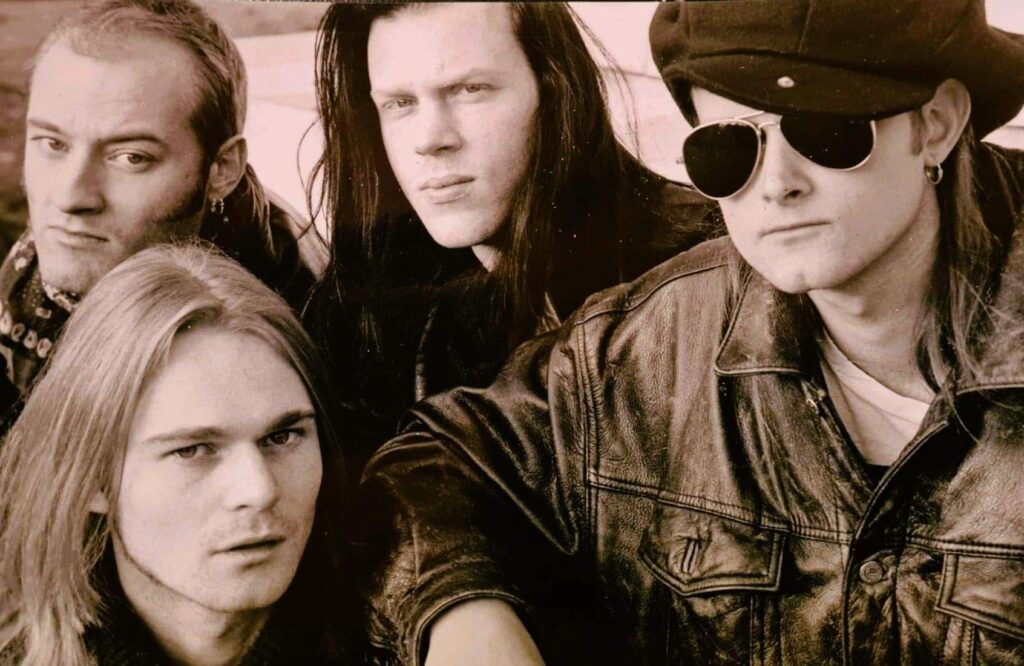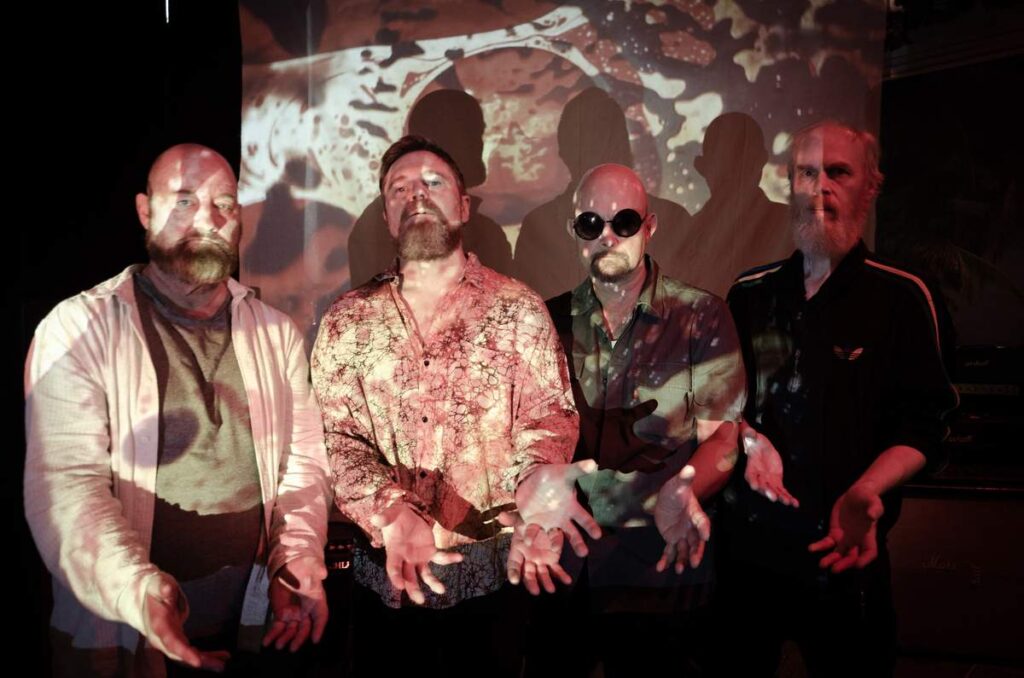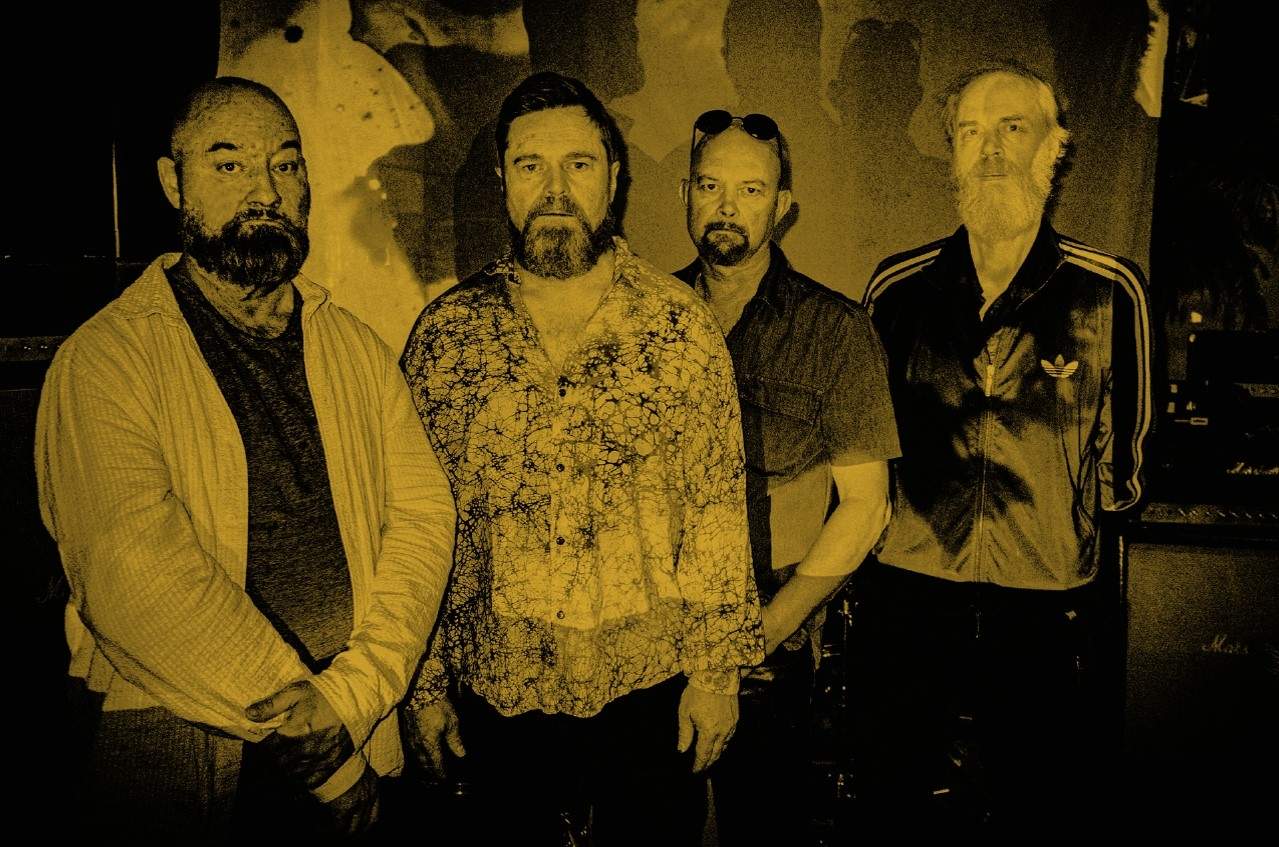‘Golden Sea’ by Gold | New Album, ‘Psychedelic Days’
G.O.L.D. is set to make a grand return with their new album ‘Psychedelic Days,’ marking their first release in over three decades. Enjoy music video for ‘Golden Sea,’ a track from the upcoming album, slated for release on October 4, 2024 via Sound Effect Records.
The original lineup—Per Svensson on vocals and guitar, Magnus Paulsson on guitar, Mårten Eriksson on bass, and Johan Bomberg on drums—has reunited to revive their high-energy rock sound, reminiscent of their early days. Recorded in just three days at Kapsylen Studio in Stockholm, the album features six fresh tracks that embody their signature psychedelic style, enhanced by guest contributions from Jörgen Wall on noise, Rasmus Alkestrand on sitar, and Nova Wistedt Bomberg on backing vocals.
Since their formation in 1989 after a gig at the legendary CBGB’s, G.O.L.D. has been noted as pioneers of the Detroit-steeped power rock scene in Sweden. Their debut album, ‘Magic Power,’ released in 1991, garnered attention for tracks like ‘Motor City’ and ‘Street Jesus.’ Despite facing setbacks, including a devastating flood that destroyed the master tapes of their second album, ‘Dangerzone,’ the band’s spirit remained unbroken. G.O.L.D. continues to draw inspiration from their past while also allowing a place to experiment.

“A raw, unpolished, direct sound was what we were looking for”
Let’s start from the beginning. What were the key influences that shaped your sound in the early days? Were there any particular bands or artists that you saw as role models?
Johan: After having lived through most of the 1980s sound, we were pretty bored with it and wanted to do something a lot more raw, back to basics, so to speak. The Cult album ‘Electric’ had quite an impact on me, and of course, bands like the Stooges, the Doors, MC5, Velvet Underground, and the sound of the ’60s and ’70s became what we were aiming for with GOLD.
Per: A raw, unpolished, direct sound was what we were looking for, and we started to rehearse. Not being able to read notes, we learned by listening and doing. Stuff we liked to listen to together in the late ’80s when we started out with GOLD were the Stooges, MC5, Velvet Underground and Nico, and of course, the Doors. A true inspiration to the sound of GOLD. Scott and Ron Ashton were the thing and sort of mentors, and Iggy had the voice, the precision in tone, and the ability to tell a story for real. The raw sound was full of energy, also transmitting energy. A great influence to many.
It is said that GOLD were pioneers, alongside Union Carbide Productions in Sweden, in creating Detroit-steeped power rock in the late ’80s, influenced by the music of the Stooges, Velvet Underground, and MC5.
Lyrically and poetically, I found the Doors were key, and also Velvet Underground and Nico. After the CBGB’s gig in 1989, we listened a lot to the Stooges’ first two albums, which are hard to beat. ‘Fun House’ especially is a favorite. This music was the origin of punk rock but had a psychedelic vibe. We later recorded MC5’s ‘Kick out the Jams’ for King Kong Records in 1992.
Can you tell us about the moment you decided to form G.O.L.D.? What was the spark that ignited this creative endeavor? How did you all come together, and what were those early jam sessions like?
Johan: Per Svensson, Mårten Eriksson, and Joyce Romano met at the Royal Institute of Art in Stockholm and started a band. A little later, I joined on drums. After getting back to Stockholm from New York in December ’89, we wanted to start something new, from scratch. So, me and Per started jamming in Per’s studio at his art school. This had to be done at night, usually between 12 a.m. and 3 a.m., when the school was empty.
Per: It’s the music, the pure energy, and the constellation of people that made the magic, together. The band was formed in 1989 after a gig at CBGB’s in New York. We got the gig after sending a cassette demo tape to Hilly Kristal in 1989. The band performed live at CBGB’s alongside New York-based artist J. Romano (The Living Room). After the gig, the band got free tickets from CBGB’s to see the Ramones live at the Ritz in New York. Back in Sweden, GOLD started to rehearse at Kasern 3 on Skeppsholmen and later at Hog Heaven on Närkesgatan in Stockholm. GOLD began recording material at Decibel Studio in Stockholm in 1989 with sound engineer Michael Sergel and at Thunderload Studios in Solna. Magnus Paulsson from Fire Engines joined on guitar. Tracks like ‘Motor City,’ ‘Street Jesus,’ ‘Magic Power,’ and ‘Real Cool Dream’ were recorded, and the group released their first 10-track album ‘Magic Power’ in 1991.
During the early ’90s, GOLD toured Sweden, Denmark, and Germany. Among the venues GOLD played were Ecstasy Club “Swedish Highlights” in Berlin, headlining alongside Union Carbide Productions, Barbue in Copenhagen (engineered by Henrik Venant on harmonica), Hog Heaven, Daily News Café, Oxen, Cityhallen in Stockholm, Östra Liden, Errols, Mud Club in Gothenburg, Skylten in Linköping, Fabriken in Jönköping, and other venues during the early ’90s. GOLD did various radio interviews on Swedish Radio P3 and P2 in music programs like “Bommen.” Later on, their second 11-track album Dangerzone was recorded in 1993-1994 and was to be released shortly after, but was unreleased due to a natural disaster. The studio, Thunderload in Solna, was situated in the subway and was flooded with water, destroying the master tapes. The whole studio was damaged. Many years later, the band members found a cassette copy of mixes with the original songs from the master, but the quality was not okay. ‘Dangerzone’ was never released. In total, this group has created over 30 tracks together. The new LP ‘Psychedelic Days’ was recorded live in the studio in three days—that’s hard to beat!

Your journey started with a gig at CBGB’s after sending a demo tape to Hilly Kristal. What was the atmosphere like performing at such an iconic venue?
Per: The concert was loud, and I guess people liked it. There were other bands too that night. We got free tickets to see the Ramones at the Ritz. CBGB’s was an old and cozy joint with great people running it, a long bar on the right, and a kind of elastic wooden stage. The walls were stuffed with music posters. It was kind of dark, with so much historic rock embedded in the walls—not so much a country, bluegrass, or blues place. When we arrived, we had no backline with us. We got an address to pick up amps and stuff. We rolled and carried the backline through the streets of Manhattan, having no money for a taxi. We had to bet our lives that the amps were returned without damage. The sound guy showed us his gun. Although the set came out fine, it was a very memorable night. At the Ritz, they played ‘These Boots Are Made for Walking’ by Nancy Sinatra before the Ramones hit the stage.
Johan: We had a gig at CBGB’s with other bands playing that night. It was a little bit chaotic since the stage had to be cleared of all the backline after the gig, including the drum kit. All the bands had their own amps and drums. Otherwise, it appeared much like an ordinary rock club.
Your debut album, ‘Magic Power,’ was released in 1991. What was the creative process behind the album? How did the sounds of Detroit rock, as influenced by the Stooges, Velvet Underground, and MC5, manifest in your music?
Per: Creating new songs after being in New York was a natural reaction. It was an inspiring trip. Coming back to Sweden to create ‘Magic Power’ was great. And our label at that time was Psychick Release, run by Carl Abrahamsson, who released the album in 1991.
Johan: Back in those days, we had no smartphones or computers. Me and Per used to record ideas and riffs on our telephone answering machines at home to remember riffs. At the rehearsal studio, we sometimes had to call home to listen to our own answering machines to remember what the riff or idea was about. Most of the songs were co-written by Per and me, then Mårten would join in and put some bass magic on it. Later on, Magnus’ eminent guitar work was added.
How did the experience of recording at Decibel Studio and Thunderload Studios influence the final sound of Magic Power? Can you share any memorable anecdotes from those recording sessions?
Johan: We recorded our first studio demo at Decibel Studios in the spring of 1990. We recorded and mixed four songs in a 30-hour straight session. I remember that we were rather frustrated with all the electric effects like reverbs and stuff. So, for the album recordings, we wanted to find a studio with a natural ambient sound. Our first choice was the Hansa Ton Studio in Berlin, but for some reason (that I don’t really remember now—probably money?) we didn’t end up recording there. Instead, we ended up at the Thunderload studio in Solna, where they had a recording room with nice acoustics too.
I had a car, a 1967 Ford Mustang, that had (while I was drunk) crashed into a light post in Stockholm city. The deal was that Styrbjörn got the car, paying with time in the studio, and I would work fixing the car, getting paid in studio time. Win-win situation! Now we ended up having more time in the studio. All of the tracks on ‘Magic Power’ were recorded “live” (except “Gold,” which was recorded at Decibel and remixed at Thunderload).
Per: Decibel was a classic old studio at Slussen in Stockholm with great sound quality, but not all songs came out as we wanted. We were talking about recording at Hansa Studios in Berlin at that time. Thunderload was close and situated in the subway, built with wooden walls. Both studios affected the sound differently. But ‘Magic Power’ came out fine. Thunderload Studios was later flooded, and the master tape was destroyed. GOLD’s second album was never released.
What did G.O.L.D. do after Magic Power? How did you evolve as a band in the years following the album’s release?
Johan: We never officially broke up. We just stopped seeing each other.
The Thunderload studio, located in a subway station, later got flooded due to a massive rainstorm, and the tapes from the second album got damaged beyond repair and lost forever. All that’s left are some low-quality cassette copies.
Gigs, especially early ones, can be transformative. How did playing at CBGB’s and receiving free tickets to see the Ramones at the Ritz impact your perspective on live performances and your approach to playing live?
Per: A sense of doing what we wanted. Live action affects creativity a lot, making new music again with inspiring memories in mind.
Looking back, how do you view the influence of CBGB’s on your music and your career? What does the legacy of such a venue mean to you now?
Per: Inspiring memories. ‘Psychedelic Days.’ We are still young inside.
Your upcoming album, ‘Psychedelic Days,’ is generating quite a buzz. How does this new album differ from Magic Power, both in terms of sound and lyrical content?
Per: The thing is it’s a natural extension of the sound we created in 1989. Now in 2024, we still have the energy because of how we create the music. Direct, unpolished, but slightly more psychedelic due to the production and adding Hammond organ, female voices, and sitar.
“It’s a bit like a 25-year sleep of ‘the sleeping beauty.”
You’re set to release ‘Psychedelic Days’ at Melody Box in Stockholm. How does it feel to return to the live scene with this new album? What are you most excited about for this release event?
Per: To be together as G.O.L.D. again after three decades, knowing the music is still full of energy and is alive. Feels great, like a new start.
Johan: After so many years not playing together, it feels great “coming back.” Since we never really broke the band up, it’s a bit like a 25-year sleep of “the sleeping beauty.” Or a family losing a child, never knowing what happened, and suddenly the return of the lost son. We are excited about the new release, and we really don’t know what to expect. A little bit of a shot in the dark. But we think we did a pretty good job, and we hope others will think so too.
Are there any new influences or experiences that have shaped Psychedelic Days?
Per: The whole journey of G.O.L.D. as a band and the ‘Psychedelic Days’ of the past. Our memories together. The lyrics are about transformation and rising like the Phoenix Bird from the ashes again. The songs still have the energy.

What are some records that you have been spinning lately?
Johan: Viagra Boys, Queens of the Stone Age.
Per: Cortex – ‘Spinal Injuries,’ G.O.L.D. – ‘Psychedelic Days,’ Stooges – ‘Fun House,’ Cosmic Garden Project – ‘The Green Reverb,’ GOAT – ‘Medicine,’ Nico – ‘Chelsea Girls.’
Klemen Breznikar
Headline photo: Cato Lein
Gold Facebook
Sound Effect Records Official Website / Facebook




